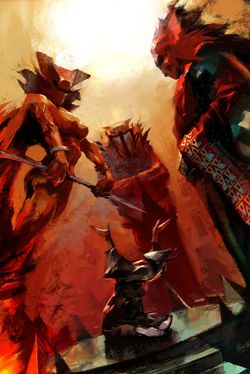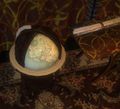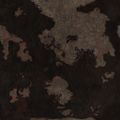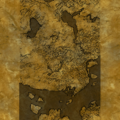Tyria (world)
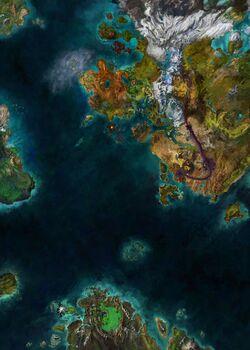
Tyria (called Thyria[1] in ancient Krytan), not to be confused with the continent of the same name, is one among many worlds found in the Mists. It is a large world with a number of continents, of which three are explored and known historically: eponymous supercontinent Tyria, its subcontinent Elona, and Cantha, separated from them by the Unending Ocean. Tyria is the main setting for the Guild Wars franchise.
Tyria has been the home of many sentient species, such as the asura, charr, dwarves, and norn among others with humans being later immigrants to the world from the Mists.[2][3] Known history puts Tyria at least over 11,000 years old, when giganticus lupicus last roamed the world. However, the earliest known human life did not appear until 786 BE.[4] Beneath the Tyrian surface runs a subterranean network of tunnels, linked by asura gates.
Chronology[edit]
Origins[edit]
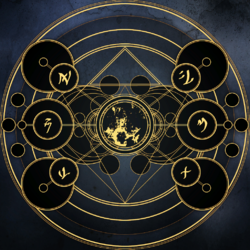 A depiction of the All which shows the Elder Dragons, spirit realms, spheres of influence and powerful magic as connected to the world of Tyria. A secluded area later known as Mother's Lament, located in southern Dragon's End of the Jade Sea in eastern Cantha in the modern day, is where the world of Tyria began taking form and where life first flourished in eras long past while various spirits roamed and began taking physical form on this nascent material plane.[5][6] The location that would one day see the building of the Harvest Temple was the first in the world of Tyria to contain a major ley line hub underneath it to direct the flow of magic.[7][8] The Elder Dragon Soo-Won was the first physical being to exist on this developing world and helped nurture life by weaving the multiple domains of magic. In so doing she helped stay the Void's unrelenting push toward entropy which would have led to Tyria and all life on it dissolving back into the primordial state in the Mists if left unchecked. To both assist her in this crucial task to preserve the world and to not feel alone, Soo-Won brought her five children—Jormag, Kralkatorrik, Mordremoth, Primordus, and Zhaitan— into being and split the domains of magic so each of these new Elder Dragons got their respective domain and the responsibility to balance the magical Antikytheria system of the All[9] while she retained control over the water domain. Due to their origins and their role as balancers of magic, the six Elder Dragons became intrinsicially connected to not only the world of Tyria in the All but also the associated spirit realms and spheres of influence.[10] However, the gifted magic began influencing the young Elder Dragons who developed their own personalities and desires as they grew up, and these differences ultimately led to clashes between siblings and their mother before they all went their separate ways to establish their domains in the forming regions across the world.[5] Once the Elder Dragons turned more and more corrupted and tormented from the Void's lingering influence in the split magic domains, they became greedy and began devouring all available ambient magic in the world while using their corrupting elemental magic to turn many sentient beings into elemental dragon minions in what became known as the first of many dragonrise cycles. Soo-Won is believed to have created spherical magic artifacts known as the Eyes of the Ocean, including the Blue Orb, which had the power to create a wide protective magical barrier around themselves which prevented new dragon minions from being created and protected uncorrupted living beings from the Elder Dragons. A theory presented in 1335 AE posits that Soo-Won may have gifted many such orbs to the nascent races of the world of Tyria over several dragonrises; if so, an unknown number of ancient civilizations and races may have potentially survived the Elder Dragons' destructive reign far beyond the later documented populated regions of Central Tyria, Cantha, and Elona.[11] |
Previous dragonrises[edit]
The true age of the world of Tyria remains unknown, with the oldest known records dating to the approximate extinction of the Giganticus Lupicus in 10,000 BE. This was the period of the Elder Dragons' last time awake in which they drove the Giganticus Lupicus to extinction.[12] Little physical or written evidence remains of the civilizations and races which existed in prior dragonrises, showing the totality of the destruction wrought by the Elder Dragons. The oldest known and identified structures and artifacts from the previous dragonrise belong to the elder races of the dwarves, Forgotten, jotun, mursaat and Seers; the origins of other old structures such as the Eye of the North and the Altrumm Mines of the Echovald Forest or relics from locations such as the Aurios Mines within the Jade Sea, and whether they date back to the prior dragonrise, remain presently unknown.[13][14][15] Dragons of all shapes, sizes, and origin called Cantha home for thousands of years.[16]
The dwarves, Forgotten, jotun, mursaat, and Seers were known as the elite who hoarded magic over the less powerful races during this time.[17] Despite their vast knowledge and mastery of magic, they too remained unaware of how many times the Elder Dragons had actually risen in the history of Tyria. The charr,[18] dwarves,[19][20] jotun,[21][22] kodan,[17] norn[22] and tengu[23] are known to have lingering stories passed down through the generations about the last rise of the Elder Dragons, with jotun stelae mentioning a "sextet of swallowers."[21] According to scholars, the very existence of these tales indicates that the Elder Dragons have awakened at least twice in history. Ancient documents, presently found in the Durmand Priory's collection, reveal accounts passed down by other races such as the powerful Seers and even the Six Human Gods themselves.[22][24]
Unlike the other four elder races, the Forgotten were an alien serpentine race worshipping the Six Human Gods and immigrated to Tyria from the Mists. They eventually joined forces with the other elder races to oppose the Elder Dragons in the first known multiracial alliance in Tyria's history. The Forgotten and the mursaat assaulted the Elder Dragon Zhaitan but failed to slay him. The mursaat blamed the lack of involvement from the dwarves, jotun and Seers in the assault as the reason for the failure. These disagreements eventually led to the alliance dissolving and the mursaat retreating into the Mists with their magic intact,[25] and they would fight a destructive war against the Seers that led to the near extinction of the latter. With the help of unknown "divine resources", the Seers were able to gather the remaining unspoiled magic in the world and lock it within a great artifact known as the first Bloodstone, eventually speeding up the Elder Dragons' fall into slumber.[26][27] Glint, scion and champion of the Elder Dragon Kralkatorrik, was freed from her master's influence via a Forgotten ritual and eventually rebelled against him by hiding the surviving races of the known world from the Elder Dragons who gradually fell into slumber to wait for the levels of magic to rise again.[28] However, this sealing of magic would also lead to the jotun's gradual downward spiral into savagery over the following centuries as they descended into a brutal civil war over scraps of power left.[29][30]
Age of the Six Human Gods[edit]
At some still-unknown point in the past, powerful beings known as the Six Human Gods traveled to Tyria via entering the Artesian Waters of Orr, bringing humanity with them and ushering a new age.[3] Under the guidance of Balthazar, the God of War, humans spread and conquered lands across the world while Melandru, the Goddess of Nature, helped turn the land verdant.[2] Lingering charr legends would give credit to Melandru as the creator of the world, suggesting that her reach was vast at the time;[31] the gods would become known as the Gods of Tyria and creators of the world and gained some nonhuman worshippers as well. The oldest known nation of humanity was Cantha—first settled in 786 BE.[4] Since then, Cantha has been said to have been settled by humans multiple times in the pre-imperial era, suggesting that the tribes that would one day become known as modern Canthans were only the latest colonizers of this fertile continent.[32]
In 205 BE, humanity traveled to the northern continents of Tyria and Elona, and established the kingdom of Orr and the Primeval Dynasty in their respective continents with some subtle suggestions that other, less known human nations were founded elsewhere as well.[33] The Luxons and Kurzicks, as well as the ethnicities that would populate Elona and Central Tyria, did not originate from Cantha; Luxons would end up having lingering stories of a distant homeland across the Unending Ocean.[32] Canthans initially remained unaware of the northern cultures' existence but eventually became aware of them, choosing instead to trade with the northern humans than try to conquer them. Encouraged by Balthazar, humanity continued to spread across the world, waging wars with the native non-human inhabitants and pushing them from their lands. In time, humans established Ascalon in the land previously conquered from the grawl by the invading charr and created many settlements in Kryta.[31][34] The Six traveled around the world and gathered various ancient artifacts which they would store in the city of Arah and the reliquaries of Siren's Landing for study and safekeeping.[35][36]
In 1 BE, Abaddon, the God of Knowledge, used the Seers' Bloodstone with other gods to grant magic to all the races of the world. However, this gift backlashed as wars between the races and people grew and intensified. King Doric of the Tyrian human kingdoms pleaded to the gods to take back their gift, and to do so the gods sundered the Bloodstone into five pieces—each representing a different school of magic (Aggression, Denial, Destruction, and Preservation) as well as a keystone required to reunite the Bloodstones into one again.[27] They then used Doric's blood to seal the magic and dropped the Bloodstones into Abaddon's Mouth, the then largest volcano in the Ring of Fire islands.[37] Magic remained in the world, but greatly reduced in its power and efficiency.[38]
Abaddon disagreed with removing magic, however. After receiving a plea for aid from his zealous Margonite followers who were hunted by the Forgotten armada due to committing crimes of killing servants of other gods and defaming god statues in the Temple of the Six Gods, Abaddon sunk the pursuing Forgotten ships and rebelled against the other gods to further his own ambitions, transforming the surviving Margonites into demonic followers to wage war on his behalf.[39] The resulting clash between the gods transformed the Crystal Sea and a verdant Elonian landscape into the Crystal Desert and the Desolation, respectively.[40] Following Abaddon's defeat, the five gods sealed him and the Margonites in the Realm of Torment with several Forgotten acting as their wardens. Because of the devastation the war had caused, the gods left the world in the Exodus of the Gods. Despite their departure, the gods still sent prophetic visions to their follows and granted their blessings, enabling resurrection via resurrection shrines.
While imprisoned, Abaddon continued scheming and used his demonic and mortal servants as well as manipulated pawns such as the charr via the titans to cause catastrophes such as the Jade Wind of Cantha in 872 AE, the Searing of Ascalon in 1070 AE, and the Cataclysm of Orr in 1071 AE which devastated their respective landscapes.
In 1075 AE, over a thousand years after the Exodus, Abaddon attempted to usher in Nightfall to merge Tyria with the Realm of Torment and thus allow himself to be released from his prison.[4] Some areas of Elona suffered the effects of Nightfall although Abaddon was ultimately defeated by a group of heroes, including Spearmarshal Kormir who ascended to take Abaddon's place in the pantheon and save all of Tyria from being ravaged by the fallen god's rampant magic.[40] With Abaddon replaced and his threat abated, the Six chose to end their lingering influence on the world of Tyria and let mortals govern it without their divine interference. Some time after this second exodus, resurrection shrines stopped working, and it became nigh impossible to resurrect dead beings in the world without help from exceedingly rare magical artifacts such as the enigmatic Eternal Flame.
Latest dragonrise[edit]
Although Kormir had been able to consume Abaddon's unleashed power during her ascension, the temporary spike in magic had lasted long enough to begin stirring the Elder Dragon Primordus from his millennia-long slumber, leading to the latest cycle of dragonrise with the rising of Primordus in 1120 AE and the catastrophes that followed.[40][41] Other Elder Dragons began waking up as well in the following centuries. The Elder Dragon Soo-Won's rise was felt by all the aquatic species of the Jade Sea and the Unending Ocean as her powerful presence drove back the shadows in the depths.[42]
Physical characteristics[edit]
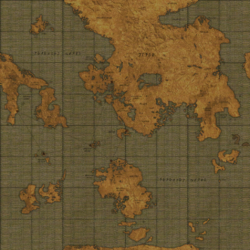
According to a New Krytan-labelled world map found in the Durmand Priory library, the world of Tyria is made up of several large land masses, among which is Cantha, which is located in the far south and a super continent also called Tyria. The supercontinent contains the familiar continent of Tyria (sometimes referred to as Central Tyria) as well as Elona (although these two together only make up about a quarter of the supercontinent).
The Priory's map also contains several other islands and continents, some of which are labelled in New Krytan. However, most of these labels seem to be descriptive rather than actual place names, as in many early world maps.
Interestingly, Lion's Arch, Kaineng Center of Old Kaineng City, Kamadan (which has since been renamed Palawadan, Jewel of Istan in honor of King Palawa Joko), and the Great Temple of Balthazar are all marked on this map, as well as two unknown locations to the west: one (apparently underwater) in the middle of the Sunken Islands, and the other nearest to the label reading Sunrise Crest. These have been speculated to be, like the other labels, existing or former port cities.
Astronomy[edit]
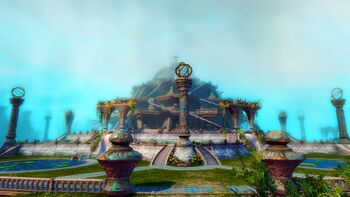
The jotun were the first species known to try to catalogue the night sky above Tyria. In the book Rising Stars, an interpretation of an ancient jotun writing, the translator states their belief that the text says the constellations themselves are altered by the awakening of Elder Dragons. This is seemingly corroborated by Varra Skylark's discovery of the Mystic Telescope in Arah.[43] Many years ago, the mysterious and cantankerous traveler Bahltek described something similar of the Six, saying, "The gods can be seen in the heavens... to varying degrees. They've emblazoned their marks upon the firmament, and these marks are not constant". Istani astronomers made claims that the stars hold prophecies of the future and even foretold events such as Nightfall.
Dwayna's Heart is a star visible in the sky above Tyria which doesn't move, akin to the North Star.
Depiction of the constellations and names of stars appear to vary by race. Known constellations in the night sky above Tyria include:
- Human constellations
- Grenth's Eye, or Eye of Grenth
- Contains the stars "Deadrun" and "Shadow"
- The Vizier's Tower
- Gnarl of Melandru
- Contains the stars "Autumn", "Dreamflower" and "Verdance"
- Hounds of Balthazar
- Kormir's Scales of Order
- Lyssa's Mirror[44]
- Contains the stars "Phantasm" and "Delusion"
- Charr constellations
- Norn constellations
- Kodan constellations[45]
- The Flamebearer
- The Spearhead
- The Hammer
- The Fisher
- Other constellations[44]
- Legendary Hero
- Contains the stars "Nevermore", "Quip" and "Minstrel"
- Staff of Joko
- Contains the stars "Desolation", "Plague" and "Scourge"
- Graven Monolith
- Contains the stars "Mallyx" and "Apocrypha"
- Dragon's Maw
- Contains the stars "Firebreath" and "Fang"
Interactive map[edit]
Gallery[edit]
| The Guild Wars Wiki has an article on Tyria (world). |
The Order Threat Assessment Board, depicting a distorted view of the world.
A fan-made map with English labels by that_shaman.
References[edit]
- ^ The Map of the All
- ^ a b Orrian History Scrolls: The Six
- ^ a b Cathedral of Silence
- The Seventh Reaper: So shall it be. You seek the heart of Orr? Then you must go to the very beginning. The rock where the gods first set foot upon this world.
- The Seventh Reaper: There is an artesian well hidden in the mountains behind the temple of Melandru. There, you will find the place where Orr began.
- ^ a b c Guild Wars 2: Path of Fire—Road to the Desert
- ^ a b Mother's Lament ambient dialogue
- ^ The Wisdom and Power of the Kodan
- ^ Battered Book
- ^ Letter to Priest Elkan
- ^ The Map of the All
- ^ Hidden Arcana
- Historian: That's a map of the All. I like to think of them as spirit realms. That's Tyria in the middle. All those other circles are spheres of influence and powerful magic.
- ^ Research Journal
- ^ GuildMag Issue 9: A New Dawn - Lore Interview with Jeff Grubb, Ree Soesbee and Scott McGough, GuildMag.com (archived)
- ^ Arrival at the Eye
- Vekk: This is impressive, even by Asuran standards.
- Ogden Stonehealer: No Dwarves made this. Is it human-built?
- <Character name>: No. This was put here by something more powerful than men.
- ^ Altrumm Ruins outpost description
- ^ The Aurios Mines outpost description
- ^ The Guild Wars Factions Manuscripts
- ^ a b Enduring Icicle
- ^ Myths and Legends of Ancient Ascalon
- ^ Unspeakable, Unknowable
- High Priest Alkar: The Stone Summit are dangerously close to uncovering the Tome of the Rubicon. Inside is the true name of the Great Destroyer, the bane of the living and nemesis of the Great Dwarf himself. If the seals that bind that book are dispelled and the true name spoken... well, let's just say there is no worse thing that could happen in this world. [...]
- High Priest Alkar: Long ago, the Great Dwarf took from his greatest foe the one thing that give him his power...he took from him his name, sealing it away until the time of their final battle.
- High Priest Alkar: To ensure the name was unspeakable to all but the Great Dwarf, the name was sealed within the Rubicon. There are few left with the knowledge and power to open the Tome.
- High Priest Alkar: If the true name of either is spoken aloud, it would mean the end of the world as we know it. We must not allow that which is unknown to again become known. Not now. [...]
- High Priest Alkar: If that Hierophant reads the Great Destroyer's true name, he will summon upon this world the most malignant creature ever seen by mortal eyes.
- ^ The Ruined City of Arah (explorable)
- Ogden Stonehealer: This isn't the first time the dragons have risen.
- Ogden Stonehealer: The Tome of the Rubicon speaks of the dwarves fighting the dragon's champions.
- ^ a b Scholar Caterin
- ^ a b c Prosperity's Mystery
- "The Nature of Dragons" by Ogden Stonehealer.
- Or, should I say the "Dragons of Nature"? Yes. Dragons have long been thought to be as much a part of Tyria as the sun, moon, land, and seas.
- No one, not even the dwarves, know how long they've been here. The jotun and the norn both have lingering stories passed down through the generations about the last rise of the dragons.
- Most scholars give these tales little credit, unfortunately, as so much time has passed. It was over ten thousand years ago that the dragons last returned to their slumber.
- The very existence of these tales, however, indicates that the dragons have awakened at least twice in history.
- Ancient documents, found now in the Durmand Priory's collection, reveal accounts passed down by other races such as the powerful Seers and even the human gods themselves.
- ^ Genzhou Talonrend
- ^ Tome of the Five True Gods
- ^ Mursaat Lore Tablet
- ^ A Study in Gold
- ^ a b The Ruined City of Arah (explorable) Seer path
- Randall Greyston: The Seers were a magical race, once close allies to the mursaat.
- Randall Greyston: When the Elder Dragons first awoke, they gathered the unspoiled magic in the world and locked it within a great artifact—the first bloodstone.
- Randall Greyston: The human gods recovered this bloodstone, and gave magic to the human race. When humanity could not handle that power, they split it into five parts.
- Randall Greyston: The first bloodstone was broken into pieces in Arah. [...]
- Randall Greyston: Fantastic! The human gods not only sundered the seer's bloodstone here—they increased its power.
- Randall Greyston: They pulled from the energies of Zhaitan himself, even though they did not know of the sleeping Elder Dragon.
- Randall Greyston: They only knew that this was a place of great magical power, and built their godly city here.
- ^ The Ruined City of Arah (explorable) Forgotten path
- Warden Illyra: I have learned that the last time the Elder Dragons came, the Forgotten worked with Glint, who hid the old races from the dragons' power. [...]
- Warden Illyra: Yes. Yes! Look at these runes. The Forgotten were able to remove Kralkatorrik's control over Glint.
- Warden Illyra: Glint remained in crystalline form, but she regained her free will and identity. [...]
- Warden Illyra: This is the altar. It was here, before the human gods came, that Glint was freed of the Elder Dragons.
- ^ The Savage Pride of the Jotun
- ^ Echoes of Ages Past
- Elder Thruln: Behold. At the height of our power, arrogance and jealousy led the jotun to civil war.
- Elder Thruln: Our blood is the blood of the mountains. In it, there is power. And so we fought...over blood itself. [...]
- Elder Thruln: The giant-kings turned on each other. Brother murdered brother. Son murdered father.
- Elder Thruln: What we did not realize is that with each death, we weakened the very blood we sought to claim.
- Elder Thruln: We tore ourselves to ribbons, scrabbling for glory. Now, we bicker over mere scraps.
- ^ a b The Ecology of the Charr
- ^ a b An Empire Divided: A Selected History of Mysterious Cantha for the Traveling Scholar
- ^ An Apple a Day
- <Character name>: Are you from Kryta?
- Doern Velazquez: Kryta? No, no...I mean, yes! Of course. The human nation, right? Kryta. Yes.
- <Character name>: That sounds mighty suspicious. Cantha? You don't look Elonian...
- Doern Velazquez: That information is classified. Maybe we'll talk more about it one day.
- ^ Planet of the Grawl
- ^ The Ruined City of Arah (explorable) Jotun path
- Varra Skylark: There are ancient jotun legends of a sky-sweeper, a great magical observatory. I believe that the human gods brought that magic telescope here and rebuilt it. [...]
- Varra Skylark: My study of those stones in the Shiverpeaks leads me to believe [the jotun] knew when the dragons would awaken.
- Varra Skylark: That knowledge was found by the human gods and brought here to Arah.
- ^ A Parable of Abaddon
- ^ Bloodstones
- ^ History of Tyria
- ^ Statue of Abaddon
- ^ a b c Facing the Truth
- Kormir: Thirteen hundred years ago, Abaddon and his army of fanatics waged a war ranging across the shores and islands of the Crystal Sea.
- Kormir: The battle was so ferocious that the ocean boiled away, leaving behind the desert you see today.
- Kormir: When the gods finally struck down Abaddon, his fall warped and ravaged these lands, creating the Desolation.
- Kormir: Abbadon remained a fallen god, imprisoned for a thousand years, until he rose to threaten Tyria one last time...
- Kormir: A mortal hero led a mission to stop him, and against all odds, succeeded. But then... [...]
- Kormir: I was there to contain the damage, but by then it was too late.
- Kormir: The surge of power upended the balance of magic in Tyria, and stirred Primordus from his slumber—triggering this latest cycle of destruction.
- ^ The Elder Dragons
- ^ Fallout
- Character name>: How long have you served Soo-Won?
- Kuunavang: I felt it when she woke. All those of the sea did—a presence powerful enough to drive back the shadows in the depths.
- Kuunavang: But it was not until Zhaitan that I sought her out. An act of desperation to save what was left of a land I loved.
- Kuunavang: It takes...effort for one like her to see you. We're but moments in her infinite life. I did not know if she would care.
- Kuunavang: But she did. Somehow, she did. I became her champion.
- ^ The Ruined City of Arah (explorable) Jotun path
- Varra Skylark: The appearance of the Elder Dragons is reflected by the stars themselves. When they awaken, so do these new stars!
- ^ a b Star Record
- ^ A Bearkin Guide to Celestial Bodies
